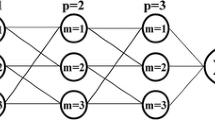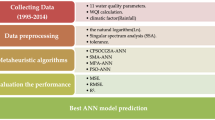Abstract
River flow modeling plays an important role in water resources management. This research aims at developing a hybrid model that integrates the feed-forward neural network (FNN) with a hybrid algorithm of the particle swarm optimization and gravitational search algorithms (PSOGSA) to predict river flow. Fundamentally, as the precision of a FNN model is essentially dependent upon the assurance of its model parameters, this review utilizes the PSOGSA for ideal preparing of the FNN model and gives the likelihood of boosting the execution of FNN. For this purpose, monthly river flow time series from 1990 to 2016 for Garber station of the Turkey River located at Clayton County, Iowa, were used. The proposed FNN-PSOGSA was applied in monthly river flow data. The results indicate that the FNN-PSOGSA model improves the forecasting accuracy and is a feasible method in predicting the river flow.








Similar content being viewed by others
References
Achela D, Fernando K (1998) Runoff forecasting using RBF networks with OLS algorithm. J Hydrol Eng 3(3):203–209
Adhikari R (2015) A neural network based linear ensemble framework form time series forecasting. Neurocomputing 157:231–242
Alweshah M (2014) Firefly algorithm with artificial neural network for time series problems. Res J Appl Sci Eng Technol 7(19):3978–3982
ASCE Task Committee on the Application of ANNs in Hydrology (2000) Artificial neural networks in hydrology, II: hydrologic application. J Hydrol Eng 5(2):124–137
Awchi TA (2014) River discharges forecasting in Northern Iraq using different ANN techniques. Water Resour Manag 28:801–814
Blum C, Socha K (2005) Training feed-forward neural networks with ant colony optimization: an application to pattern classification. In: IEEE fifth international conference on hybrid intelligent systems (HIS’05), Rio de Janeiro, Brazil, pp 233–238
Bozorg-Haddad O, Janbaz M, Loáiciga HA (2016) Application of the gravity search algorithm to multi-reservoir operation optimization. Adv Water Resour 98:173–185
Brauer KH (2015) A hydrologic model of Upper Roberts Creek and exploration of the potential impacts of conservation practices. M.Sc. Thesis, University of Iowa, Iowa City, IA, USA, p 138. Retrieved from http://ir.uiowa.edu/etd/1953/
Brown ME, Lary DJ, Vrieling A, Stathakis D, Mussa H (2008) Neural networks as a tool for constructing continuous NDVI time series from AVHRR and MODIS. Int J Remote Sens 29(24):7141–7158
Burney SMA, Jilani TA, Ardil C (2005) Levenberg–Marquardt algorithm for karachi stock exchange share rates forecasting. World Acad Sci Eng Technol 3:171–176
Carvalho JP, Camelo FV (2015) One day ahead stream flow forecasting. In: 16th world congress of the international fuzzy systems association (IFSA) and the 9th conference of the European Society for fuzzy logic and technology (EUSFLAT), Gijon, Asturias (Spain), pp 1168–1175
Cells M, Rylander B (2002) Neural network learning using particle swarm optimization. Adv Inf Sci Soft Comput 2002:224–226
Ch S, Anand N, Panigrahi BK, Mathur S (2013) Streamflow forecasting by SVM with quantum behaved particle swarm optimization. Neurocomputing 101:18–23
Chai T, Draxler RR (2014) Root mean square error (RMSE) or mean absolute error (MAE)?–Arguments against avoiding RMSE in the literature. Geosci Model Dev 7(3):1247–1250
Clerc M, Kennedy J (2002) The particle swarm-explosion, stability, and convergence in a multidimensional complex space. IEEE Trans Evol Computat 6(1):58–73
Dawson CW, Abrahart RJ, See LM (2007) HydroTest: a web-based toolbox of evaluation metrics for the standardised assessment of hydrological forecasts. Environ Model Softw 22(7):1034–1052
Deo RC, Şahin M (2016) An extreme learning machine model for the simulation of monthly mean streamflow water level in eastern Queensland. Environ Monit Assess 188:90
Delafrouz H, Ghaheri A, Ghorbani MA (2017) A novel hybrid neural network based on phase space reconstruction technique for daily river flow prediction. Soft Comput 2017:1–11. https://doi.org/10.1007/s00500-016-2480-8
Eberhart R, Kennedy J (1995) A new optimizer using particle swarm theory. In: IEEE 6th international symposium in micro machine and human science, Nagoya, Japan, pp 39–43
Engel J (1988) Teaching feed-forward neural networks by simulated annealing. Complex Syst 2:641–648
Gairaa K, Khellaf A, Messlem Y, Chellali F (2016) Estimation of the daily global solar radiation based on Box-Jenkins and ANN models: a combined approach. Renew Sustain Energy Rev 57:238–249
Ghorbani MA, Zadeh HA, Isazadeh M, Terzi O (2016a) A comparative study of artificial neural network (MLP, RBF) and support vector machine models for river flow prediction. Environ Earth Sci 75:476
Ghorbani MA, Khatibi R, Goel A, Fazelifard MH, Azani A (2016b) Modeling river discharge time series using support vector machine and artificial neural networks. Environ Earth Sci 75:685
Goyal MK, Bharti B, Quilty J, Adamowski J, Pandey A (2014) Modeling of daily pan evaporation in sub-tropical climates using ANN, LS-SVR, fuzzy logic, and ANFIS. Expert Syst Appl 41:5267–5276
Heo KY, Ha KJ, Yun KS, Lee SS, Kim HJ, Wang B (2014) Methods for uncertainty assessment of climate models and model predictions over East Asia. Int J Climatol 34:377–390
Husken M, Stagge P (2003) Recurrent neural networks for time series classification. Neurocomputing 50:223–235
Jain A, Kumar AM (2007) Hybrid neural network models for hydrologic time series forecasting. Appl Soft Comput 7(2):585–592
Jiang S, Zhicheng J, Wang Y (2015) A novel gravitational acceleration enhanced particle swarm optimization algorithm for wind-thermal economic emission dispatch problem considering wind power availability. Electr Power Energy Syst 73:1035–1050
Kalteh AM (2013) Monthly river flow forecasting using artificial neural network and support vector regression models coupled with wavelet transform. Comput Geosci 54:1–8
Kang F, Xu Q, Li J (2016) Slope reliability analysis using surrogate models via new support vector machines with swarm intelligence. Appl Math Model 40(11–12):6105–6120. https://doi.org/10.1016/j.apm.2016.01.050
Kang F, Li J, Xu Q (2017a) System reliability analysis of slopes using multilayer perceptron and radial basis function networks. Int J Numer Anal Methods Geomech 41(18):1962–1978. https://doi.org/10.1002/nag.2709
Kang F, Liu J, Li J, Li S (2017b) Concrete dam deformation prediction model for health monitoring based on extreme learning machine. Struct Control Health Monit 24(10):e1997. https://doi.org/10.1002/stc.1997
Kashani MH, Daneshfaraz R, Ghorbani MA, Najafi MR, Kisi O (2015) Comparison of different methods for developing a stage–discharge curve of the Kizilirmak River. J Flood Risk Manag 8:71–86
Kayarvizhy N, Kanmani S, Uthariaraj RV (2014) ANN models optimized using swarm intelligence algorithms. WSEAS Trans Comput 13:501–519
Kennedy J, Eberhart R (1995) Particle swarm optimization. In: Proceedings of IEEE international conference on neural networks, Preth, WA, Australia. vol 4, pp 1942–1948
Kisi O, Cimen M (2011) A wavelet-support vector machine conjunction model for monthly streamflow forecasting. J Hydrol 399(1–2):132–140
Kisi O, Alizamir M, Zounemat-Kermani M (2017) Modeling groundwater fluctuations by three different evolutionary neural network techniques using hydroclimatic data. Nat Hazards 87(1):267–381
Krause P, Boyle D, Bäse F (2005) Comparison of different efficiency criteria for hydrological model assessment. Adv Geosci 5(5):89–97
Kuok KK, Harun S, Shamsuddin SM (2009) Particle swarm optimization feedforward neural network for hourly rainfall-runoff modeling in Bedup Basin, Malaysia. Int J Civ Environ Eng 9(10):20–39
Legates DR, McCabe GJ (1999) Evaluating the use of “goodness-of-fit” measures in hydrologic and hydroclimatic model validation. Water Resour Res 35(1):233–241
Maier HR, Dandy GC (2000) Neural networks for the prediction and forecasting of water resources variables: a review of modelling issues and applications. Environ Model Softw 15(1):101–124
Mirjalili SA, Hashim SZM, Sardroudi HM (2012) Training feedforward neural networks using hybrid particle swarm optimization and gravitational search algorithm. Appl Math Comput 218:11125–11137
Montana DJ, Davis L (1989) Training feedforward neural networks using genetic algorithms. In: 11th international joint conference on artificial intelligence, Detroit, MI, USA. vol 1, pp 762–767
Nash J, Sutcliffe J (1970) River flow forecasting through conceptual models part I—a discussion of principles. J Hydrol 10(3):282–290
Nayak PC, Sudheer KP, Rangan DM, Ramasastri KS (2004) A neuro-fuzzy computing technique for modeling hydrological time series. J Hydrol 291(1–2):52–66
Ojugo AA, Emudianughe J, Yoro RE, Okonta EO, Eboka AO (2013) A hybrid artificial neural network gravitational search algorithm for rainfall runoffs modeling and simulation in hydrology. Prog Intell Comput Appl 2(1):22–33
Rajaee T, Mirbagheri SA, Kermani MZ, Nourani V (2009) Daily suspended sediment concentration simulation using ANN and neuro-fuzzy models. Sci Total Environ 407:4916–4927
Rashedi E, Nezamabadi-pour H, Saryazdi S (2009) GSA: a gravitational search algorithm. Inf Sci 179(13):2232–2248
Settles M, Rodebaugh B, Soule T (2003) Comparison of genetic algorithm and particle swarm optimizer when evolving a recurrent neural network. In: Cantú-Paz E et al (eds) Genetic and evolutionary computation—GECCO 2003. Lecture Notes in computer science, vol 2723. Springer, Berlin, Heidelberg, pp 148–149
Taylor KE (2001) Summarizing multiple aspects of model performance in a single diagram. J Geophys Res 106(7):7183–7192
Wang WC, Chau KW, Cheng CT, Qiu L (2009) A comparison of performance of several artificial intelligence methods for forecasting monthly discharge time series. J Hydrol 374(3–4):294–306
Willmott CJ, Robeson SM, Matsuura K (2012) A refined index of model performance. Int J Climatol 32(13):2088–2094
Zhang JR, Zhang J, Lok TM, Lyu MR (2007) A hybrid particle swarm optimization–back-propagation algorithm for feedforward neural network training. Appl Math Comput 185(2):1026–1037
Author information
Authors and Affiliations
Corresponding author
Ethics declarations
Conflict of interest
All authors declare that they have no conflict of interest.
Ethical approval
This article does not contain any studies with human participants or animals performed by any of the authors.
Additional information
Communicated by V. Loia.
Rights and permissions
About this article
Cite this article
Meshram, S.G., Ghorbani, M.A., Shamshirband, S. et al. River flow prediction using hybrid PSOGSA algorithm based on feed-forward neural network. Soft Comput 23, 10429–10438 (2019). https://doi.org/10.1007/s00500-018-3598-7
Published:
Issue Date:
DOI: https://doi.org/10.1007/s00500-018-3598-7




